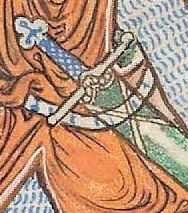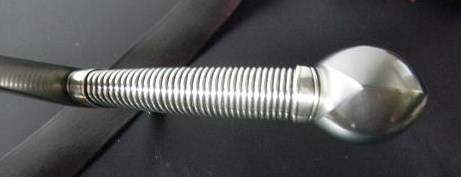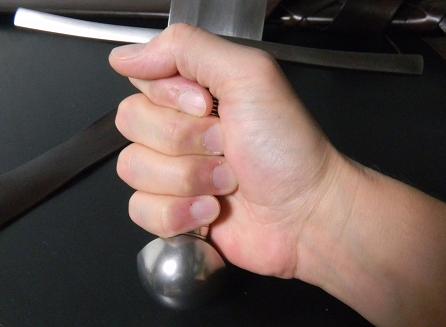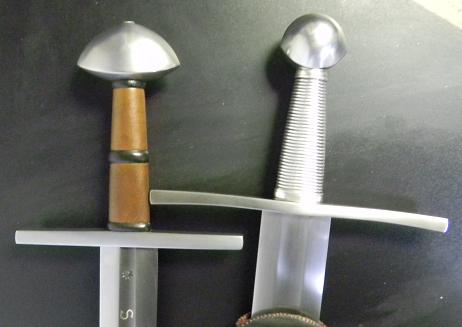Posts: 1,606 Location: Chicago, Illinois
Wed 03 Jul, 2013 2:25 pm
| Leo Todeschini wrote: |
It also had a strange effect on me in that when looking at the sword from a few paces away it looks really quite small, definitely elegant, but small.
Tod |
I feel the same way. It's really odd. I think it is the pomel that does it. The pommel looks small but because of it's almost spherical shape it has more mass than you think. Weird that we had the same impression...
Posts: 1,606 Location: Chicago, Illinois
Wed 03 Jul, 2013 2:55 pm
Posts: 625 Location: Louisiana / Nordrhein-Westholland
Wed 03 Jul, 2013 5:13 pm
| Tim Lison wrote: |
| I took one "in hand" because those always look good. |
Right you are, it looks really excellent in the hand. The proportions are great.
Posts: 5,739 Location: Wichita, Kansas
Wed 03 Jul, 2013 5:30 pm
Peter,
Thank you for the additional information on the grip and scabbard. Your creative hypothesis on the belt attachment is an interesting one, and gives the ensemble a unique look. The ferrules and wire wrap on the grip aren't commonly seen on swords of this period. The treatment gives the sword and entirely different look than it would have otherwise, very nice.
Tim,
Thanks for the in-hand photos, they give one a good sense of the swords proportions. Overall, a very sleek looking piece.
Posts: 605
Wed 03 Jul, 2013 8:43 pm
Very nice sword Tim, congratulations. I have long wanted to see one of these 12th C swords with the almost spherical
Geibig type 14 pommels recreated, so to see one done by Peter is a special treat indeed.
Posts: 8,310 Location: Montreal,Quebec,Canada
Thu 04 Jul, 2013 3:30 am
The pommel looks like it is very comfortable as it supports the heel of the palm: The pic of it from the side really helps in understanding the subtle shape.
Lovely sword. :D :cool:
Posts: 1,717 Location: Buffalo, NY.
Thu 04 Jul, 2013 5:10 am
That's superb Tim,
Here's a hearty congratulations on such a monumental piece. A truly beautiful weapon indeed.
Posts: 133 Location: Atlanta , Gawga
Thu 04 Jul, 2013 6:32 am
Congratulations.
It would be a realization of a dream to caretake a PJ creation. Many generations will enjoy this heirloom. I bet it feels unreal ... do you keep pinching yourself?
I love the clean look of the pommel . silver wire and bands hilt arrangement,
Well done.
Posts: 1,606 Location: Chicago, Illinois
Thu 04 Jul, 2013 10:27 am
| Jean Thibodeau wrote: |
| The pommel looks like it is very comfortable as it supports the heel of the palm |
This is actually the most comfortable to wield sword I have because of the pommel shape. The bottom curve means nothing pokes the hand and the spherical shape keeps it firmly locked in place. Makes me wonder why this pommel wasn't more common.
Posts: 74 Location: Zvolen Slovakia
Fri 05 Jul, 2013 2:27 am
Nice sword Tim,Peter is a true master.
Posts: 1,302 Location: Jackson, MS, USA
Fri 05 Jul, 2013 3:41 am
| Peter Johnsson wrote: |
The scabbard is an attempt to make a mid 12th century style. Looking at art from the period we do not see the iconic integral laced belt of the 13th and early 14th century of the kid we are used to. Instead there are some enigmatic depictions of thongs in a basket weave in the upper quarter or third of the scabbard. It also seems like the slashes in the scabbard cover is still includes a central cut, like a remnant of the scabbard slide of previous centuries. This was what I came up with to combine those features depicted in art. A prequel to the laced belt of the later periods.
Below are a few examples of depictions of swords with this kind of suspension.
Any questions and comments are welcome.
-Thanks! |
Beautiful work, sir.
The 12th century is a difficult period to document. Here is a simplified example from the 13th century Trinity Apocalypse, Cambridge MS R.16.2 folio 23v, which may give some interesting clues. (I've rotated it for ease.) It seems the belt is simply placed under the criss-cross lacing. Some of the same manuscript's miniatures simply show the belt disappearing behind the sheath. I suppose it would allow a good deal of flexibility to the owner: the belt could be over or under the sheath; and depending upon the placement through mutiple Xs, one could have the sword straight or at varying cants, higher or lower.
 Attachment: 73.43 KB
Attachment: 73.43 KB

Posts: 746 Location: Louisiana
Fri 05 Jul, 2013 11:08 am
| Mart Shearer wrote: |
| Peter Johnsson wrote: | The scabbard is an attempt to make a mid 12th century style. Looking at art from the period we do not see the iconic integral laced belt of the 13th and early 14th century of the kid we are used to. Instead there are some enigmatic depictions of thongs in a basket weave in the upper quarter or third of the scabbard. It also seems like the slashes in the scabbard cover is still includes a central cut, like a remnant of the scabbard slide of previous centuries. This was what I came up with to combine those features depicted in art. A prequel to the laced belt of the later periods.
Below are a few examples of depictions of swords with this kind of suspension.
Any questions and comments are welcome.
-Thanks! |
Beautiful work, sir.
The 12th century is a difficult period to document. Here is a simplified example from the 13th century Trinity Apocalypse, Cambridge MS R.16.2 folio 23v, which may give some interesting clues. (I've rotated it for ease.) It seems the belt is simply placed under the criss-cross lacing. Some of the same manuscript's miniatures simply show the belt disappearing behind the sheath. I suppose it would allow a good deal of flexibility to the owner: the belt could be over or under the sheath; and depending upon the placement through mutiple Xs, one could have the sword straight or at varying cants, higher or lower. |
(Sorry for the sidetrack Tim)
I will have to respectfully disagree with Mr. Johnsson when he says "Looking at art from the period we do not see the iconic integral laced belt of the 13th and early 14th century of the kid we are used to". I think there are a number of illustrations that very well could be the typical integral lacing we are used to, or atleast something not far off from it. For example
From the Bayeux Tap
[ Linked Image ]
M/S Lat 8846 fol62 (12th C.)
[ Linked Image ]
There are many others from the period that may be similar to the other common lacing style that forms a Z rather than an X (as on the lacing of the St. Maurice (Turin) scabbard)
[ Linked Image ]
[ Linked Image ]
As always, using illustrations in this manner is open to interpretation. However, I do think that there are enough illustrations from the 11th-12th C that could be interpreted to be the lacing styles that we know from surviving later scabbards.
That is not saying that I think these are the only styles, obviously there are other lacing styles as in the illustrations Mr. Johnsson linked to. I just don't think it is correct to say that we don't see any evidence from the 11th-12th C for the integral lacing we are all used to.
Also, it's worth noting that there is atleast one early 12th C surviving scabbard leathers from York that show piercing along the top that would be consistent with some form of integral lacing. While we don't know how it was laced, it does look quite similar to the piercing found along the "iconic" suspension system we are all used to.
[ Linked Image ]
That said, I really do like what you did with the scabbard for this project. Variety is important, and while I find myself defending the typical integral lacing in this post, overall I believe it is overrepresented. It is good to see a different method used.
Posts: 1,757 Location: Storvreta, Sweden
Fri 05 Jul, 2013 11:51 am
Robin, thanks!
Those were some really good and clear examples. Very happy that you posted those.
Having a good reference material for scabbards is really important. It is easier now, with good things available on the net, but it is still time consuming to get hold of a good variety spanning different identified areas and time periods.
Good stuff :-)
The lacing of the Saint Maurice in Torino is a good example of a lacing that looks fairly normal when seen from the front. The back side is a bit surprising. I do not think the back side has been published. I was at least surprised when I got to see it. The thong that is used for the lacing is actually a separate length of leather, while both the belts are of a different kind of leather and each separate from the lacing thong itself.
I will make use of the data I got from that session of documentation for a sword sometime and at that time show my drawings of the original with an analysis of how the lacing was done.
Posts: 1,903 Location: Toronto
Sun 07 Jul, 2013 8:44 am
What an elegant and beautiful sword! Congratulations Tim and Peter.
I agree that when the eye wanders toward the hilt it looks smaller, but there's a lot of blade there. Yet somehow it balances out. I particularly like the pommel which reminds me of a sword in Paris, perhaps the one already mentioned.
I had to pass on one of Peter's swords earlier this year because of current financial constraints - feeling the pain now.
Regards, JD
-
Posts: 1,265 Location: Malaysia
Sun 07 Jul, 2013 5:26 pm
Peter Johnsson custom sword
[ Linked Image ]
What a nice sword! But I think this one is perhaps suitable for reenactments. ;)
Posts: 1,757 Location: Storvreta, Sweden
Sun 07 Jul, 2013 9:43 pm
Re: Peter Johnsson custom sword
| Shahril Dzulkifli wrote: |
[ Linked Image ]
What a nice sword! But I think this one is perhaps suitable for reenactments. ;) |
Thanks!
This sword could surely serve someone who is into reenactment of the 12th century.
Is this a problem?
:-)
Posts: 236 Location: Central CA
Mon 08 Jul, 2013 11:47 am
Incredible work as always Peter! And a heart-felt congratulations to you Tim. :D What a nice sword and scabbard combination from a period that really interests me.
You
cannot post new topics in this forum
You
cannot reply to topics in this forum
You
cannot edit your posts in this forum
You
cannot delete your posts in this forum
You
cannot vote in polls in this forum
You
cannot attach files in this forum
You
can download files in this forum



